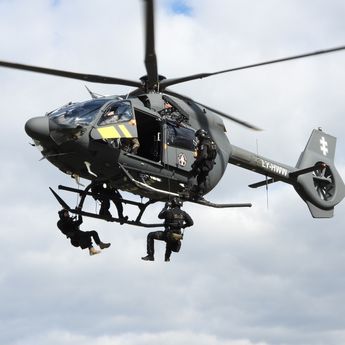In response to rising customer demand, Airbus Helicopters is expanding its distance learning offers by making a greater number of training courses available remotely, such as type ratings, recurrent trainings and familiarisation courses.
“Pilot and technician training is a key element of aviation safety that we are continuously improving and innovating to better serve our customers,” says Sabrina Barbera, Head of Training & Flight Ops at Airbus Helicopters. “Remote courses allow customers to perform training wherever they are based, without having to travel, which significantly decreases the overall cost and makes certain courses more accessible in all ways for our customers.”
Distance learning comes in two formats, enabling an enhanced training experience and flexibility: virtual classroom sessions, led by an instructor, and e-learning modules for independent study.
This type of learning is best suited for theoretical courses focused on knowledge acquisition – either non-qualifying refresher courses, or the theoretical portion of qualifying courses – whereas simulator training or practical hands-on training must be performed live in a helicopter with an instructor, and with the appropriate hygiene and physical distancing measures in place.
Distance learning accelerated by the pandemic
Some distance courses now becoming permanent fixtures in the course catalogue were specifically developed by Airbus Helicopters, in collaboration with aviation authorities, to maintain training continuity throughout the COVID-19 pandemic.
“The COVID-19 crisis reinforced the need for both onsite and distance learning,” says Barbera, “and enabled us to accelerate the efforts already in place.”
Thanks to the agility of its 20 training centres, Airbus Helicopters has been able to remain operational during the crisis, with many pilots and technicians having been trained locally at its height.
“At this stage, we’re still receiving many requests for technician remote refresher training to support the restarting of operations in Asia-Pacific,” says Colin Wong, Head of Training and Flight Operations, Asia-Pacific. “The distance learnings performed in the early days of the pandemic have given our instructors valuable insight into how to conduct virtual classroom sessions.”

What’s on the virtual menu?
Today, around 25 distance learning solutions are widely available to customers around the world.
“Our aim is to have as many customers as possible attending these important training courses which enhance flight safety,” says Barbera.
“With distance learning, our customers can adjust their schedule to their needs. For example, a technician could perform their routine aircraft checks in the morning and evening while squeezing in distance learning in between, thereby keeping skills fresh,” adds Alain Salendre, Airbus Helicopters Training Services General Manager in France.
In North America, for example, “we are currently developing an H125 recurrent pilot ground school e-learning module. If this is successful, we aim to do the same for an H125 maintenance refresher course,” says Lindsay Cunningham, head of training at Airbus Helicopters’ North American affiliate. “We chose these courses because we believe e-learning is well suited for shorter courses for customers who are already familiar with our products and looking to refresh their knowledge base or learn about the latest product updates.”

The ingredients of successful distance learning
On the trainees’ side, distance learning requires pre-requisites such as a personal computer, internet devices, a built-in camera, a microphone, a secured connection and bandwidth in order to participate.
On the instructor’s side, Airbus has adapted the environment with tailored hardware. “We now have a separate large TV display showing all the faces of the trainees so that valuable non-verbal communication cues are not lost,” says Wong.
In addition, course content, assessment methods and rules of interaction are developed specifically for the remote learning environment.
“We set ground rules for interactions initiated by instructor and those initiated by trainees,” says Wong. “Quizzes have become an important way to gauge trainee progress. We also found that having a ‘helper’ to take care of the administrative issues made a great difference. It minimised the instructor’s workload.”
The relationship between instructor and trainees is equally important in creating trust and confidence and makes the learning experience an enjoyable and fruitful one.
The full list of e-learnings and virtual classroom courses can be consulted via the Learning Management System (LMS). Additional courses will be added over time.
#MakingMissionsPossible #training





